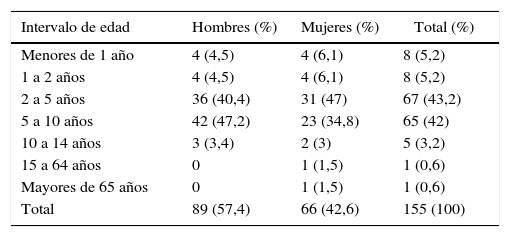La tinea capitis (TC) es una dermatofitosis que afecta al pelo y el cuero cabelludo. La epidemiología de la TC depende de las distintas zonas geográficas y es variable en el tiempo. El examen microscópico directo y el cultivo de hongos son fundamentales para confirmar la sospecha diagnóstica e identificar el germen involucrado.
ObjetivosDeterminar la frecuencia de TC, identificar los agentes etiológicos y analizar los aspectos epidemiológicos, en pacientes con sospecha de TC de Santiago Norte, durante el período 2009-2015.
Materiales y métodosUn total de 505 pacientes con sospecha de TC fueron evaluados en el Laboratorio de Dermatología, Hospital Clínico Universidad de Chile. Se realizó examen microscópico directo con KOH 30% y cultivo de hongos de lesiones de cuero cabelludo. La identificación de los hongos fue principalmente morfo-fisiológica.
ResultadosEl diagnóstico de TC se confirmó en 155 casos (30,7%). Se observó predominio del sexo masculino (57,4%). La edad promedio fue de 5años. El 85,2% de los casos ocurrieron en población preescolar y escolar. El agente aislado más frecuente fue Microsporum canis en el 89,8%, seguido por Trichophyton tonsurans en el 7,1%. Se confirmó que el 81,8% de los casos de Trichophyton tonsurans tenían ascendencia extranjera, principalmente de Haití y Perú.
ConclusionesEste estudio evidenció la aparición de Trichophyton tonsurans como causante de TC, lo que podría explicarse por el aumento de la población inmigrante y las características antropofílicas del dermatofito.
Tinea capitis (TC) is a dermatophytosis that affects the hair and scalp. The epidemiology of TC depends on the different geographical areas and is variable over time. Direct microscopic examination and fungal culture are essential to confirm the diagnostic suspicion and to identify the germ involved.
ObjectivesTo determine the frequency of TC, to identify the etiological agents and to analyze the epidemiological aspects, in patients with suspected TC from Santiago Norte during the period 2009-2015.
Materials and methodsA total of 505 patients with suspected TC were evaluated in the Dermatology Laboratory, Hospital Clinico Universidad de Chile. Direct microscopic examination was performed with KOH 30% and fungal culture of scalp lesions. Identification of the fungi was mainly morpho-physiological.
ResultsThe diagnosis of TC was confirmed in 155 cases (30.7%). Male gender predominated (57.4%). The average age was 5years. 85.2% of the cases occurred in the preschool and school population. The most frequent isolated agent was Microsporum canis in 89.8%, followed by Trichophyton tonsurans in 7.1%. It was confirmed that 81.8% of the cases of Trichophyton tonsurans had foreign ancestry, mainly of Haiti and Peru.
ConclusionsThis study evidenced the occurrence of Trichophyton tonsurans as a cause of TC, which could be explained by the increase in the immigrant population and the anthropophilic characteristics of the dermatophyte.
Artículo
Comprando el artículo el PDF del mismo podrá ser descargado
Precio 19,34 €
Comprar ahora











